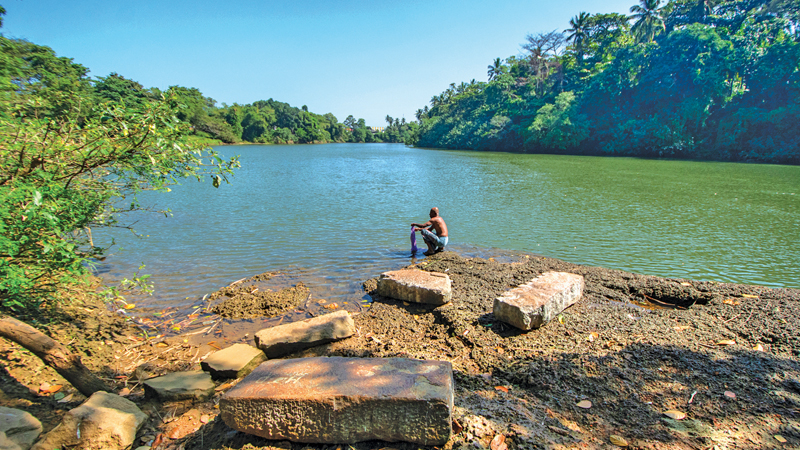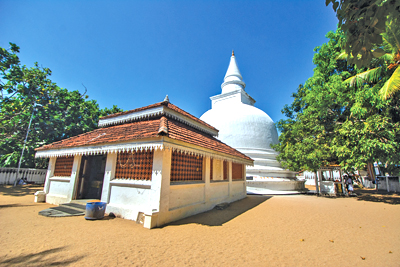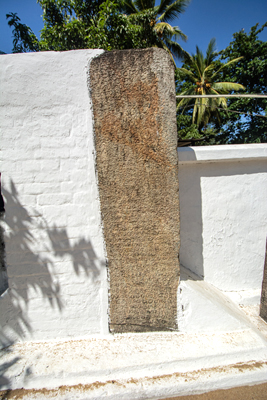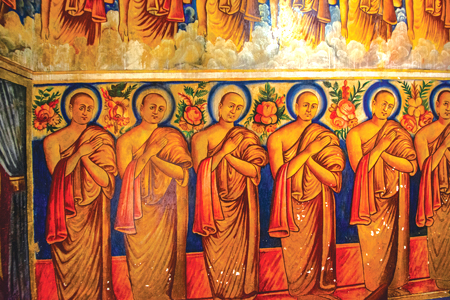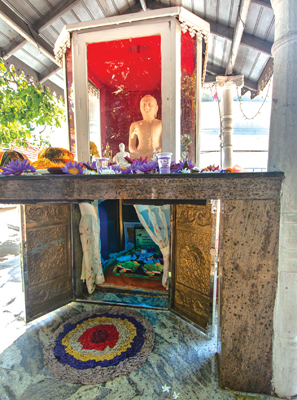The ‘Sivrudagaba’ in Kelaniya-by Mahil Wijesinghe
Source:sundayobserver
Image Source:sundayobserver
Learn about the fascinating history of the Kithsrimevan Kelani Raja Maha Vihara where the Buddha’s bathing robe is believed to be enshrined in the dagaba known as ‘Sivrudagaba’
After visiting the Kelaniya Raja Maha Vihara last week, I stepped down under the magnificent white-painted archway and moved towards a shady tree in the lower terrace in search of an elderly villager who promised to keep my shoes until I returned from the temple.
While I was taking leave from him, he inquired, “Mahattaya Egoda Kelaniya pansalata yannenedda? ‘Sivrugala’ ethana thiyenawa, Ekath Balanna”. (Sir, why don’t you visit the Egoda Kelaniya temple? ‘Sivrugala’ is over there). He showed me the way to the temple on the opposite bank of the Kelani Ganga from the main Kelaniya Raja Maha Vihara. The villagers refer to this temple as the Egoda Kelani Vihara. The glistening white-washed dagaba of the Vihara stands majestically against the clear blue sky surrounded by a white wall with nicely carved oil lamp cavities.
Following the directions of the villager, I made my way to the Egoda Kelani Vihara. Strolling at the edge of the Kelaniya River, I first came across a ‘Sivrugala’, an ancient stone carved slab which the villager pointed out to me.
“Sivrugala had been in the upper terrace of the Kelaniya Temple for a long time. Now, it has been placed over there on the bank of the river,” the villager said. Sivrugala is a seven- foot long and nearly two feet tall decorated granite stone slab, believed to have been graced by the Buddha on his third visit to the island. It is said that the Buddha bathed in the Kelani Ganga, which flows close to the temple.
The sacred stone of Sivrugala will soon be displayed to devotees for veneration in a beautiful structure, which is being built on the bank of the Kelani Ganga in front of the Kelaniya Raja Maha Vihara. Walking along the bank of the Kelani Ganga, I stumbled upon a massive ruined stone pillar of antiquity which had fallen on to the river bank.
Villagers use this stone pillar to wash their clothes. Crossing the bridge, I ventured into the temple. A ferry service is also operated across the river which is quite adventurous for the young visitors to the Kelaniya Temple, who use it to reach the Kithsirimevan Kelani Raja Maha Vihara.
Wooded grove
The historical Kithsirimevan Kelani Raja Maha Vihara is in a wooded grove on the opposite of the Kelani Ganga close to the main Kelaniya Raja Maha Vihara. Although it is separated from the Kelaniya Raja Maha Vihara today, the custodianship of the Kithsirimevan Kelani Raja Maha Vihara comes under the chief incumbent of the Kelaniya Raja Maha Vihara Ven. Prof. Kollupitiye Mahinda Sangharakkhitha Thera.
The historical significance of the temple is unique and interesting. According to chronicles, on the invitation of Naga King Maniakkitha, the Buddha visited Kelaniya on a Vesak Poya Day on his third visit to the island. During the visit, before partaking of a mid-day meal prepared by King Maniakkitha, the Buddha with 500 disciples reached the bank of the Kelani Ganga and bathed there.
On this occasion, it is said, that the Buddha stamped his sacred footprint on the river bed for the veneration of the Naga kings, and the ‘Nanakadaya’ robe he clad during his bath was offered to King Maniakkitha.
It is said that the Naga King had built the dagaba that enshrined a relic of the bathing robe (jalasaatikawa) where the Buddha had changed his bathing robes. Today, the dagaba is known as ‘Sivrudagaba’ which stands majestically in the premises of the Kithsirimevan Kelani Raja Maha Vihara.
The Sivrudagaba, said to have been originally built by the Naga King Maniakkitha had been renovated under royal patronage from time to time. Later, King Kirthi Sri Megawarna or Kithsirimevan (847-875 BC) had widened and renovated this dagaba. It is after him that the temple is named the Kithsirimevan Kelani Raja Maha Vihara. The bathing robe of the Buddha (jalasaatikawa) is enshrined in the dagaba. It is believed that this is only dagaba in the world, which had been built enshrining a bathing robe (jalasaatikawa) of the Buddha, which is proved by two ancient stone inscriptions in the temple premises.
Walking around the temple premises, I found several ruins of ancient stone sculptures such as a torso of a Buddha statue, stone inscriptions and some parts of stone pillars on the temple ground. An ancient Na tree is seen in the left corner of the dagaba, with a Devale nearby, where devotees pay veneration. A few yards from the dagaba, an elegant Bo tree enclosure is also being built in the lower terrace of the temple which contains beautiful carvings of elephant heads.
Footprint of the Buddha
Peace and tranquility prevail in the surrounding atmosphere of the Sivrudagoba of the Kithsirimevan Kelani Raja Maha Vihara which stands on a sandy compound covered by a green canopy. A special feature of the dagaba is its ‘Sripathula’ or Sacred Footprint of the Buddha which is venerated by devotees. Most visitors to the main Kelaniya Raja Maha Vihara miss this ancient temple as they have no knowledge of it.
Villagers believe in the miraculous powers of this revered site once graced by the Buddha. Most villagers come here to make vows at the ‘Siripathula’ for recovery from various ailments and to get blessings.
The present dagaba is believed to have been renovated during the latter part of the Kandyan Kingdom and the adjoining shrine has beautiful murals dating back to the early 1900s, while the serene cross-legged Buddha statue belongs to the Kandyan period.
It is a peaceful place to sit and pray in. As I sat outside, a few devotees explained the history of the temple. Every time I visit a religious monument, it is these conversations with the bhikkhus and devotees that I cherish, for they are extremely enlightening.


